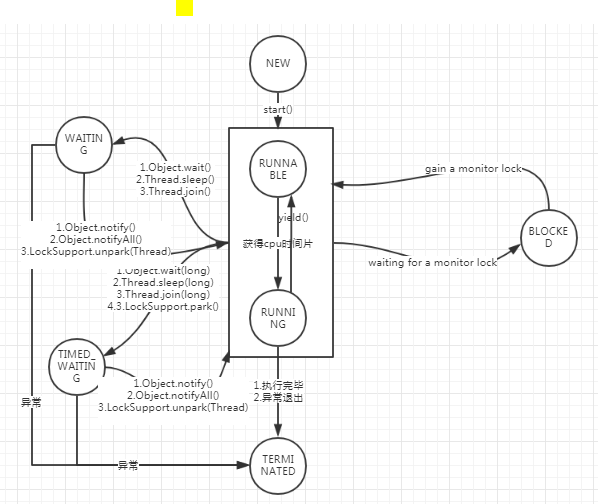并发编程—1线程基础
目录
1.线程的基础和线程的共享和协作
1.1 基础概念
线程 vs 进程
进程:程序运行时,资源分配的最小单位。进程内会有一个或者多个线程,线程间共享这个进程的资源。
线程:cpu调度的最小单位,依赖进程而存在。
并发 vs 并行
并发:单位时间内,可以处理事情的能力。
并行:同一时刻,可以同时处理事情的能力。
并发编程的好处和注意事项
好处:充分利用了cpu的资源。加快用户的响应时间,程序的模块化和异步化。
注意事项:
- 并发会存在死锁的情况
- 并发共享资源,会存在冲突的情况。
- 过多的线程会导致机器宕机。
守护线程
随着主线程结束而结束的线程。和主线程共死。
例如GC线程。
特别地,如果一个线程被设置为守护线程,那么线程内容的finally代码不一定总被执行。
创建线程的几种方式
- 继承Thread
- 实现Runnalbe
- 实现Callable + FutureTask
/*实现Callable接口,允许有返回值*/
private static class UseCall implements Callable<String>{
@Override
public String call() throws Exception {
System.out.println("I am implements Callable");
return "CallResult";
}
}
public static void main(String[] args)
throws InterruptedException, ExecutionException {
UseCall useCall = new UseCall();
FutureTask<String> futureTask = new FutureTask<>(useCall);
new Thread(futureTask).start();
System.out.println(futureTask.get());
}
停止线程的几种方式
线程正常执行结束
线程执行过程中抛出异常
stop resume
这2个方法是强制中断吸纳线程,已经被废弃的方法。
interrupt()、 isInterrupted() 、static interrupted()
- interrupt()方法是告诉线程需要中断一些,但是是否会中断由线程自身决定。所以一般结合isInterrupted() 、static interrupted()2个方法一起使用。
- isInterrupted() 返回当前线程的中断状态,不会重置线程的中断状态。
- static interrupted() 返回当前线程的中断状态,并且会重置isInterrupted()为false
在sleep(),wait()等方法都会抛出一个InterruptedException,这时候捕获这个异常的时候,要主动重新调用interrupt()方法。否则可能无法正确中断线程。
如何程序员需要安全的中断一个线程,需要通过while轮询的方式去判断一个线程的标志位。如下:
public class EndRunnable {
private static class UseRunnable implements Runnable{
@Override
public void run() {
String threadName = Thread.currentThread().getName();
while(Thread.currentThread().isInterrupted()) {
System.out.println(threadName+" is run!");
}
System.out.println(threadName+" interrput flag is "
+Thread.currentThread().isInterrupted());
}
}
public static void main(String[] args) throws InterruptedException {
UseRunnable useRunnable = new UseRunnable();
Thread endThread = new Thread(useRunnable,"endThread");
endThread.start();
Thread.sleep(20);
endThread.interrupt();
}
}
/**
*
*类说明:抛出InterruptedException异常的时候,要注意中断标志位
*/
public class HasInterrputException {
private static SimpleDateFormat formater
= new SimpleDateFormat("yyyy-MM-dd HH:mm:ss_SSS");
private static class UseThread extends Thread{
public UseThread(String name) {
super(name);
}
@Override
public void run() {
String threadName = Thread.currentThread().getName();
while(!isInterrupted()) {
try {
System.out.println("UseThread:"+formater.format(new Date()));
Thread.sleep(3000);
} catch (InterruptedException e) {
System.out.println(threadName+" catch interrput flag is "
+isInterrupted()+ " at "
+(formater.format(new Date())));
interrupt();
e.printStackTrace();
}
System.out.println(threadName);
}
System.out.println(threadName+" interrput flag is "
+isInterrupted());
}
}
public static void main(String[] args) throws InterruptedException {
Thread endThread = new UseThread("HasInterrputEx");
endThread.start();
System.out.println("Main:"+formater.format(new Date()));
Thread.sleep(800);
System.out.println("Main begin interrupt thread:"+formater.format(new Date()));
endThread.interrupt();
}
}
线程的状态

1.2 线程之间的共享
synchronized内置锁
用于控制不同线程间对于同一个对象的控制。
对象锁和类锁
volatile 关键字
volatile关键字的作用:用来保证对变量修改后,能立即写回主存,从而保证共享变量的修改对所有线程是可见的。JVM语言规范将该特性称为happens-before。具体可以参考AtomicInteger类里面的incrementAndGet的实现
cup core cup core
+ register(寄存器) (修改v1) + register(寄存器)(读取v1)
+ cache(一级或多级高速缓存)(v1) + cache(一级或多级高速缓存) (v1)
|| ||
VV VV
=================================================================
RAM(内存) v1 给v1增加volatile修饰可以保存线程对v1的修改可以立刻协会内存。保证了v1对其他线程的可见性。
=================================================================
1.3 线程私有变量 ThreadLocal
- get() 获取每个线程自己的threadLocals中的本地变量副本。
- set() 设置每个线程自己的threadLocals中的线程本地变量副本。
ThreadLocal有一个内部类ThreadLocalMap:
public T get() {
Thread t = Thread.currentThread();
//根据当前的线程返回一个ThreadLocalMap.点进去getMap
ThreadLocalMap map = getMap(t);
if (map != null) {
ThreadLocalMap.Entry e = map.getEntry(this);
if (e != null) {
@SuppressWarnings("unchecked")
T result = (T)e.value;
return result;
}
}
return setInitialValue();
}
//点击去getMap(t)方法发现其实返回的是当前线程t的一个内部变量ThreadLocal.ThreadLocalMap
ThreadLocalMap getMap(Thread t) {
return t.threadLocals;
}
//由此可以知道,当调用ThreadLocal的get方法是,其实返回的是当前线程的threadLocals(类型是ThreadLocal.ThreadLocalMap)中的变量。调用set方法也类似。
//举例一个使用场景
/**
* ThreadLocal使用场景:把数据库连接对象存放在ThreadLocal当中.
* 优点:减少了每次获取Connection需要创建Connection
* 缺点:因为每个线程本地会存放一份变量,需要考虑内存的消耗问题。
* @author luke Lin
*
*/
public class ConnectionThreadLocal {
private final static String DB_URL = "jdbc:mysql://localhost:3306:test";
private static ThreadLocal<Connection> connectionHolder = new ThreadLocal<Connection>(){
protected Connection initialValue() {
try {
return DriverManager.getConnection(DB_URL);
} catch (SQLException e) {
e.printStackTrace();
}
return null;
};
};
/**
* 获取连接
* @return
*/
public Connection getConnection(){
return connectionHolder.get();
}
/**
* 释放连接
*/
public void releaseConnection(){
connectionHolder.remove();
}
}
//解决ThreadLocal中弱引用导致内存泄露的问题的建议
+ 声明ThreadLoal时,使用private static修饰
+ 线程中如果本地变量不再使用,即使使用remove()
1.4 线程间的协作
wait() notify() notifyAll()
//1.4.1通知等候唤醒模式
//1)等候方
获取对象的锁
在循环中判断是否满足条件,如果不满足条件,执行wait,阻塞等待。
如果满足条件跳出循环,执行自己的业务代码
//2)通知方
获取对象的锁
更改条件
执行notifyAll通知等等待方
//1.4.2
//wait notify notifyAll都是对象内置的方法
//wait notify notifyAll 都需要加synchronized内被执行,否则会抱错。
//执行wait方法是,会让出对象持有的锁,直到以下2个情况发生:1。被notify/notifyAll唤醒。2。wait超时
//1.4.3 举例使用wait(int millis),notifyAll实现一个简单的线城池超时连接
/*
* 连接池,支持连接超时。
* 当连接超过一定时间后,做超时处理。
*/
public class DBPool2 {
LinkedList<Connection> pools;
//初始化一个指定大小的新城池
public DBPool2 (int poolSize) {
if(poolSize > 0){
pools = new LinkedList<Connection>();
for(int i=0;i < poolSize; i++){
pools.addLast(SqlConnectImpl.fetchConnection());
}
}
}
/**
* 获取连接
* @param remain 等待超时时间
* @return
* @throws InterruptedException
*/
public Connection fetchConn(long millis) throws InterruptedException {
// 超时时间必须大于0,否则抛一场
synchronized (pools) {
if (millis<0) {
while(pools.isEmpty()) {
pools.wait();
}
return pools.removeFirst();
}else {
// 超时时间
long timeout = System.currentTimeMillis() + millis;
long remain = millis;
// 如果当前pools的连接为空,则等待timeout,如果timeout时间还没有返回,则返回null。
while (pools.isEmpty() && remain > 0) {
try {
pools.wait(remain);
remain = timeout - System.currentTimeMillis();
} catch (InterruptedException e) {
e.printStackTrace();
}
}
Connection result = null;
if (!pools.isEmpty()) {
result = pools.removeFirst();
}
return result;
}
}
}
/**
* 释放连接
*/
public void releaseConn(Connection con){
if(null != con){
synchronized (pools) {
pools.addLast(con);
pools.notifyAll();
}
}
}
}
1.5 sleep() yield()
sleep会让出cpu时间轮转片,然后等待sleep时间结束或者被interrupt后,重新竞争cpu时间片。
yield方法会让出cpu时间轮转片,同时立刻重新竞争cpu时间片.
1.6 join()
面试点:线程A执行了县城B的join方法,那么线程A必须等到线程B执行以后,线程A才会继续自己的工作。
1.7 wait() notify() yield() sleep()对锁的影响
面试点:
线程执行yield(),线程让出cpu执行时间,和其他线程同时竞争cup执行机会,但如果持有的锁不释放。
线程执行sleep(),线程让出cpu执行时间,在sleep()醒来前都不竞争cpu执行时间,但如果持有的锁不释放。
notify调用前必须持有锁,调用notify方法本身不会释放锁。
wait()方法调用前必须持有锁,调用了wait方法之后,锁就会被释放。当wait方法返回的时候,线程会重新持有锁。
posted on 2019-05-17 22:56 lukelin1989 阅读(120) 评论(0) 编辑 收藏 举报





